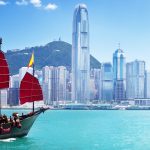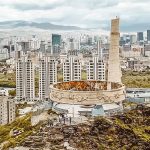Shawls, Markets and Politics in Kabul
It wasn’t the unexploded mines that lurked in seemingly every empty city lot. It wasn’t the teenage boys shooting out store signs with AK-47s at three in the morning, or the brutish blue-eyed war orphans who didn’t beg so much as persistently demand my cloth bills of Afghanis. It wasn’t even the knee-high mud that tried to suck off my boots as I crossed streets marauded by dangerously fast Pakistani SUVs. The most difficult part of negotiating the Kabul market disguised as a local was mastering the over-the-shoulder shawl swoop.
It was a coarse, brown woolen shawl I’d picked up in Rawalpindi, long and wide, like the shawls men drape around themselves to keep warm from Amritsar, India, to Mazar-e-Sharif, near the Afghanistan-Uzbekistan border. But the Afghans had a way of wrapping themselves in the thick fabric so that it didn’t slip off and trail them like a misbegotten tail. They swooshed it over their left shoulders like Errol Flynn getting ready for a chandelier swing, yet in one of Kabul’s sudden winter showers, they could seemingly materialize a hood from the oversized blanket at will.
Besides that, though, I was pretty confident I would fit right in. Two months of travel in India and Pakistan had ravaged me with several bouts of giardiasis, hallucinatory fevers, and other illnesses, meaning my look had quickly deteriorated from well-fed American to haunted Central Asian. I hadn’t brought a razor, so my beard was as full as it was ever going to get, and the barber in Peshawar had given me the closely cropped hair many Afghan men favor.
As for my outfit, I’d shelled out a few dollars for a black shalwar kameez, the national outfit for men: a long-sleeved collared shirt that fell to the knees, over puffy drawstring pants. I was wearing U.S. Army combat boots on my feet, but everyone was painted with winter mud up to their shins, so they might as well have been Skecher Catskills.
When I looked at myself in the mirror before heading out of the house I was staying in, I saw a relatively tall but otherwise unprepossessing Hazara tribesman, a member of that Shi’ite ethnic group that traced its descent directly from garrison soldiers of Genghis Khan’s conquering armies but had become a somewhat oppressed minority.
“You look like Taliban,” Nasim, the innkeeper, said proudly, looking like a mother seeing her daughter off to the senior prom.
Well, except for that damn shawl slipping off all the time.
It’s fair to say that looking like a local was critical to my self-preservation. It was February, as anti-Americanism was reaching a fever pitch over the imminent Iraq invasion, and the hatred was palpable in the Muslim world. Friendly acquaintances in Peshawar had warned me to claim any nationality but my own when I met someone even in broad daylight. When I had ridden on a 50-rupee Pashtun bus crossing the bandit-ridden Khyber Pass, where kidnapping has been an industry for centuries, we were stopped several times by nasty-looking men with the usual AK-47s. Luckily, they didn’t notice my backpack, which the driver had stowed under the seats, and I stayed quietly covered in my shawl. I had made it into Afghanistan a little carsick from the bumpiest, and probably most harrowing, ride of my life, but otherwise unharmed.
In Kabul most mornings for two weeks, therefore, I hoped that my luck would hold out, performed my best shawl swoop and headed out the door into the heart of the war-ravaged capital of a country we’d bombed slightly further back into the Stone Age. Except for the occasional blue-on-white UN sports utility vehicle, U.S. or allied military patrol or, very rarely, President Hamid Karzai’s U.S. Special Forces bodyguards (who resemble ZZ Top), I saw no other foreigners in the street. For understandable reasons, most UN workers work in building compounds surrounded by high walls topped with barbed wire. Reporters hang out and brag to each other in a hotel teahouse off Chicken Street with state-of-the-art CD burners, Internet access, and lots of Radiohead on the stereo. As soon as their patrols are over, U.S. and I.S.A.F. (International Security Assistance Force) troops immediately scamper back to their fortified bases and piped-in Fox News or Belgian beer nights, dreaming of supermarkets and Baywatch reruns. On duty, they almost never leave their vehicles.
“I ***** hate it here. This is the worst place in the world,” a young Marine muttered to me once at the U.S. Embassy when no one else was around.
He’d only been there four weeks.
On my first walkabout, it was other Marines who taught me my first lesson about the nature of the peace in Kabul, touted by the Western forces as Afghanistan’s model city.
Two young Afghan men had been trying to lead me to the U.S. embassy, where I had an interview for a story for a Canadian newspaper, but after a recent week in New Delhi, I was mistrustful of any altruism. In a busy downtown market area, I spotted a parked bus carrying two Marines and a local driver. I made a beeline for it and knocked on the window, dressed in my Hazara garb, but the Marines tensed up and shouted for me to go away. They looked scared and very jumpy. Only when I pressed my passport against the pane did one of the Marines open up the door.
“We can’t help you,” he said. “We have no idea where we are. And sorry, we didn’t know you were an American.”
It was only then that I noticed that the other Marine had been pointing an M-16 at me.
The two young Afghan men walked over three kilometers with me to make sure I arrived at the embassy safely.
But I felt no empathy for the Marines, because when I travel, I have to mingle, and so I mingled. And in this sodden grey capital, I found one of the most vibrant bazaars I had ever visited in Asia.
With Afghans less talkative than Indians or even Pakistanis, I found that I could get away with not saying anything at all as I stumbled from the street of burqha shops or cookingware vendors to, say, the streets that specialized only in caged birds. I only needed to speak enough of the local Persian dialect, Dari, to figure out how many Afghanis I had to give up to get a biryani-style lunch or the ubiquitous Afghan flatbreads that boys carry from oven to table like stacks of sweaters at The Gap. A couple of U.S. dollars got me a razor-sharp Afghan penknife to cut fruit. And among the moneychangers on the bridge that spanned the inexplicable, huge trench in the middle of the old city, I learned to disappear as soon as the Afghan policemen showed up and beat the moneychangers so hard with their assault rifles that you could hear the hollowness in the businessmen’s chests. I also learned to keep track of those moneychangers, so they could pay me the rest of my Afghanis before they slipped away after their beatings.
I even came to appreciate the picture stands, after the longest period in my life without seeing a female face. After the Taliban was driven out, so went its harsh prohibition against human likenesses, and astute merchants now seem to make a good living selling cheaply copied photographs of Bollywood actresses. I realized I’d never appreciated the bridge of a woman’s nose until I’d seen it without a blue burqha covering most of it.
By the end of two weeks, I was squatting in the mud like any Afghan, scooping kebab or biryani into my mouth and watching the Pashtun tribesmen haggle over astrakhan hats with Tajik vendors, with beautiful snowcapped mountains in the near distance. I finally felt like a local in Afghanistan .
Until the ancient Hazara load carrier tapped me on the shoulder.
“Your shawl,” he said in pretty good English. “It’s dragging on the ground.”




acheter kamagra pharmacie gracieux ans
générique pas cher kamagra canada
discount enclomiphene purchase online safely
get enclomiphene price generic
ordering androxal generic switzerland
how to buy androxal generic prices
get flexeril cyclobenzaprine price by pharmacy
cheap flexeril cyclobenzaprine purchase tablets
buy dutasteride in Australia
get dutasteride cheap canadian pharmacy
buy cheap fildena cost new zealand
fildena saturday
cheap gabapentin australia online generic
purchase gabapentin cheap online pharmacy
generic itraconazole canada pharmacy
how to buy itraconazole no prescription needed
how to buy staxyn generic mastercard
cheapest buy staxyn canada fast shipping
purchase avodart australia online no prescription
cheap avodart canada discount
rifaximin perscriptions
purchase rifaximin cheap in uk
buy xifaxan overnight cod
cheapest buy xifaxan canada generic
koupit kamagra los angeles kalifornie
koupit kamagra přes noc